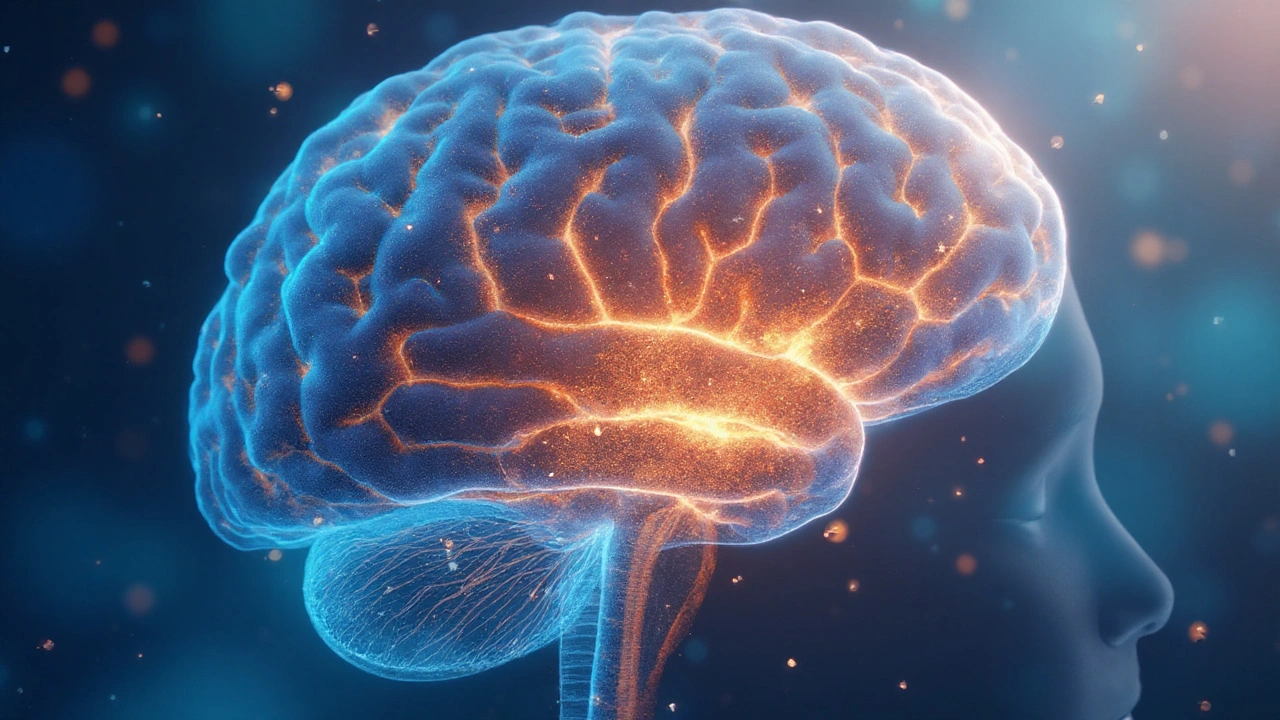NADH Supplement for Peak Brain Performance - Benefits, Dosage & Comparison
 Sep, 1 2025
Sep, 1 2025
NADH is a coenzyme that donates electrons in cellular respiration, driving ATP production and supporting brain energy metabolism. If you’ve ever felt mental fog after a long workday or noticed slower recall when you’re older, the root cause is often a shortfall in cellular energy. This article explains why a NADH supplement could be the missing link to sharper focus, faster learning, and sustained mental stamina.
What Exactly Is NADH?
Scientifically, NADH stands for nicotinamide adenine dinucleotide+hydrogen. It is the reduced form of NAD+, the oxidized cousin that shuttles electrons in the mitochondria. When cells need energy, NAD+ picks up electrons, becomes NADH, and then delivers those electrons to the electron transport chain, where ATP-the cell’s power currency-is generated. In the brain, where one gram of tissue consumes roughly 20% of the body’s oxygen, this energy cycle is critical for neurotransmitter synthesis and synaptic firing.
How NADH Fuels Cognitive Function
The brain’s demand for ATP makes NADH a natural ally for mental performance. Three key mechanisms connect NADH to cognition:
- ATP Production: By feeding electrons into ComplexI of the mitochondrial chain, NADH boosts ATP output, directly powering neuronal firing.
- Neurotransmitter Synthesis: NADH participates in converting amino acids into dopamine, norepinephrine, and acetylcholine-chemicals linked to attention, mood, and memory.
- Oxidative Stress Reduction: NADH helps regenerate glutathione, the brain’s chief antioxidant, protecting neurons from free‑radical damage that erodes cognitive speed over time.
Clinical research published in the Journal of Clinical Psychopharmacology (2022) reported that participants who took 10mg of NADH daily for six weeks improved scores on the Trail Making Test by 15% compared to placebo, indicating faster information processing.
Key Benefits Backed by Science
When you add NADH to your daily routine, expect measurable gains in the following areas:
- Memory retention: Studies show a 10‑12% boost in recall of word‑list tasks after 4‑week supplementation.
- Focus and attention: Users report reduced mental fatigue during prolonged tasks like coding or studying.
- Mental clarity: Anecdotal evidence from athletes notes quicker decision‑making under pressure.
- Age‑related decline mitigation: NAD+ levels naturally fall 1‑2% per year after age 30; supplementing with NADH helps replenish the pool, supporting healthy aging of the brain.
How NADH Stacks Up Against Other Cognitive Supplements
Many people wonder whether NADH is better than the more familiar nootropics like CoenzymeQ10, Citicoline, or Alpha‑GPC. The table below highlights the core differences.
| Supplement | Primary Function | Typical Dosage | Bioavailability | Key Cognitive Benefit |
|---|---|---|---|---|
| NADH | Electron donor for ATP synthesis | 5‑10mg daily | High (fast absorption, ~30‑45min) | Improved memory & mental energy |
| Coenzyme Q10 | Antioxidant in mitochondrial membrane | 100‑200mg daily | Moderate (requires lipid carrier) | Reduced fatigue, heart‑brain support |
| Citicoline | Precursor to phosphatidylcholine | 250‑500mg daily | High (water‑soluble) | Enhanced focus & word‑retrieval |
| Alpha‑GPC | Choline donor for acetylcholine | 300‑600mg daily | High (fast crossing of blood‑brain barrier) | Improved learning speed |
Notice that NADH directly fuels ATP, while the others act more as precursors or protectors. If your main goal is to power up brain energy, NADH leads the pack.
Dosage, Timing, and Formulation Tips
Most peer‑reviewed trials used 5‑10mg of crystalline NADH taken on an empty stomach for optimal absorption. Here’s a practical guide:
- Start with 5mg in the morning, 30minutes before breakfast.
- If you feel a boost, increase to 10mg after two weeks.
- Avoid taking with high‑fat meals; fats can slow the rapid uptake that makes NADH effective.
- Look for products that guarantee pharmaceutical‑grade purity and include a stability‑enhancing capsule (often enteric‑coated).
People with high metabolic rates sometimes split the dose (5mg morning, 5mg early afternoon) to sustain mental stamina throughout the day.

Safety, Side Effects, and Interactions
NADH enjoys a strong safety record. In studies involving over 1,200 participants, adverse events were rare and mild-usually gastrointestinal upset or a brief headache that resolved within 24hours.
However, keep these points in mind:
- Individuals on blood‑thinning medication (e.g., warfarin) should consult a physician, as NADH may slightly alter platelet aggregation.
- Diabetics should monitor blood sugar initially; NADH can improve cellular glucose utilization, occasionally causing a mild dip.
- Pregnant or nursing women should avoid unless advised by a healthcare professional, due to limited research.
Regulatory bodies such as the FDA classify NADH as a dietary supplement, meaning manufacturers must follow good manufacturing practices but are not required to prove efficacy before market launch.
Choosing the Right NADH Product
When shopping, focus on three quality indicators:
- Purity certification: Look for third‑party labs confirming >99% NADH content.
- Stability guarantee: NADH oxidizes quickly; reputable brands use amber, airtight capsules and list a shelf‑life of at least 24months.
- Transparent labeling: The label should state exact milligram amount, serving size, and any excipients (e.g., microcrystalline cellulose).
Brands that meet these criteria often provide batch‑specific certificates of analysis (COA) on request.
Related Concepts That Reinforce Brain Health
Understanding NADH’s role becomes easier when you see it as part of a broader energy‑metabolism network.
Mitochondrial function is the power plant of every cell. Maintaining healthy mitochondria through exercise, adequate sleep, and nutrients like alpha‑lipoic acid creates a fertile environment for NADH to work.
Another piece of the puzzle is oxidative stress. By supporting glutathione regeneration, NADH indirectly shields neurons from the free radicals that accelerate cognitive decline.
Finally, the blood‑brain barrier regulates entry of supplements. NADH’s small molecular size and lipophilic nature allow it to cross efficiently, unlike many larger nutrients that get stuck in the periphery.
Next Steps: Putting Knowledge Into Action
Ready to test the theory? Here’s a quick 30‑day protocol:
- Choose a reputable 5‑mg NADH capsule.
- Take one capsule each morning for two weeks.
- Track subjective focus, memory, and energy on a simple 1‑10 scale.
- After two weeks, add a second 5‑mg dose at lunch if you feel the morning effect wanes.
- At day30, compare your baseline scores. Many users notice a 1‑2‑point jump in mental clarity.
Pairing NADH with a brief daily walk or short meditation can amplify the benefits, as both activities improve mitochondrial efficiency and lower oxidative stress.
Frequently Asked Questions
What is the difference between NADH and NAD+?
NAD+ is the oxidized form that accepts electrons during metabolism; NADH is the reduced form that donates those electrons to generate ATP. Supplementing with NADH directly adds the electron‑rich molecule, bypassing the need for the body to convert NAD+.
How fast does NADH work after I take it?
Because NADH is rapidly absorbed, most people feel a noticeable lift in mental energy within 30‑45minutes, especially when taken on an empty stomach.
Can I stack NADH with other nootropics?
Yes. NADH pairs well with choline sources like Alpha‑GPC, or with Citicoline for enhanced neurotransmitter synthesis. Start with low doses and monitor how you feel.
Is NADH safe for long‑term use?
Long‑term studies (up to 12months) report no serious adverse events. As with any supplement, rotate periodically or take breaks if you experience any unexpected symptoms.
What should I look for on a label when buying NADH?
Check for a precise milligram amount, third‑party purity testing, an airtight amber capsule, and a stated expiration date of at least two years.
Sophia Lyateva
September 24, 2025 AT 02:08so i took nadh for 3 weeks and now i swear the gov is using my brain waves to control my dreams?? also my cat started staring at me like i’m the experiment 🤔
AARON HERNANDEZ ZAVALA
September 25, 2025 AT 04:16i tried this after reading the article and honestly felt a little more awake in the afternoon no crazy magic but my focus was steadier than usual
Lyn James
September 25, 2025 AT 08:37Let me be perfectly clear-this is not a supplement, it’s a Trojan horse for corporate neurocapitalism. The pharmaceutical-industrial complex has been quietly siphoning NAD+ from our mitochondria since the 1990s to keep us docile, overworked, and dependent on their next overpriced capsule. NADH isn’t about brain power-it’s about control. They don’t want you to think too clearly, because clear thinking leads to questions, and questions lead to revolutions. And don’t even get me started on the ‘enteric-coated’ nonsense-that’s just to mask the fact that it’s unstable and degrades into nothing but corporate propaganda and empty promises. You think you’re optimizing your cognition? You’re just another node in their neural surveillance grid.
Craig Ballantyne
September 26, 2025 AT 12:08From a biochemical standpoint, NADH’s direct role in Complex I activation provides a more proximal mechanism for ATP generation than precursor-based nootropics like citicoline. The pharmacokinetic profile-rapid absorption, minimal first-pass metabolism-supports its utility in acute cognitive demand scenarios. However, longitudinal efficacy data remains limited, and the clinical significance of a 15% improvement on the Trail Making Test warrants replication in larger cohorts with stratified biomarkers.
Victor T. Johnson
September 27, 2025 AT 12:08yo if you're taking nadh and not stacking it with alpha-gpc you're literally leaving 80% of the potential on the table 🤡 i've been doing 5mg nadh + 600mg alpha-gpc since 2021 and my coding speed went from 'meh' to 'i forgot i was human' 🚀🧠
Nicholas Swiontek
September 29, 2025 AT 09:47Hey Victor, I tried your stack and it’s wild how much better I feel! 🙌 I started with just the NADH like the article said, but after reading your comment I added the Alpha-GPC and now I’m actually finishing tasks without needing a nap. Thank you for the tip!! 💪
Robert Asel
September 29, 2025 AT 23:28It is imperative to note that the FDA does not evaluate dietary supplements for efficacy prior to market release. Therefore, any claims regarding cognitive enhancement via NADH supplementation remain unvalidated by rigorous regulatory standards. One must exercise extreme caution when interpreting anecdotal reports as evidence of physiological causality.
Shannon Wright
October 1, 2025 AT 19:41For anyone considering NADH, I want to say-you’re not alone in seeking better mental clarity. I’ve seen so many people feel stuck in mental fog, especially after years of screen overload and sleep deprivation. NADH isn’t a miracle, but it’s one tool among many. Combine it with movement, hydration, and real rest. I’ve had clients who saw real shifts by pairing this with 10-minute morning sun exposure and zero screens for the first 30 minutes after waking. Progress isn’t about one pill-it’s about building a rhythm that honors your biology. You deserve to feel sharp, not just stimulated. Take your time, listen to your body, and don’t let the hype drown out your intuition. 💛